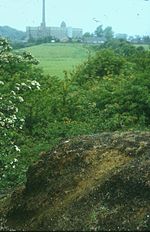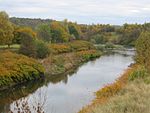Prestolee Aqueduct
1793 establishments in EnglandBridges across the River IrwellBridges completed in 1793Grade II listed bridges in Greater ManchesterGrade II listed canals ... and 4 more
Navigable aqueducts in EnglandUnited Kingdom bridge (structure) stubsUnited Kingdom canal stubsUse British English from December 2017

Prestolee Aqueduct is a stone-built aqueduct in Prestolee, Kearsley in the Metropolitan Borough of Bolton, Greater Manchester, England. The four-arch structure was constructed in 1793 to carry the Manchester, Bolton and Bury Canal across the River Irwell. It is now preserved as a Grade II listed building.The aqueduct is one of two remaining major structures on the canal, the other being the Clifton Aqueduct. A third major aqueduct, Damside Aqueduct, was demolished in the 1950s. As of 2007, the aqueduct still carried water, although it was not navigable as adjoining sections of the canal are in need of restoration.
Excerpt from the Wikipedia article Prestolee Aqueduct (License: CC BY-SA 3.0, Authors, Images).Prestolee Aqueduct
Seddons Fold Bridge,
Geographical coordinates (GPS) Address External links Nearby Places Show on map
Geographical coordinates (GPS)
| Latitude | Longitude |
|---|---|
| N 53.5525 ° | E -2.3764 ° |
Address
Prestolee Aqueduct
Seddons Fold Bridge
M26 1PJ , Stoneclough
England, United Kingdom
Open on Google Maps









